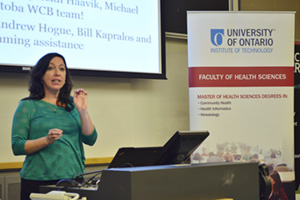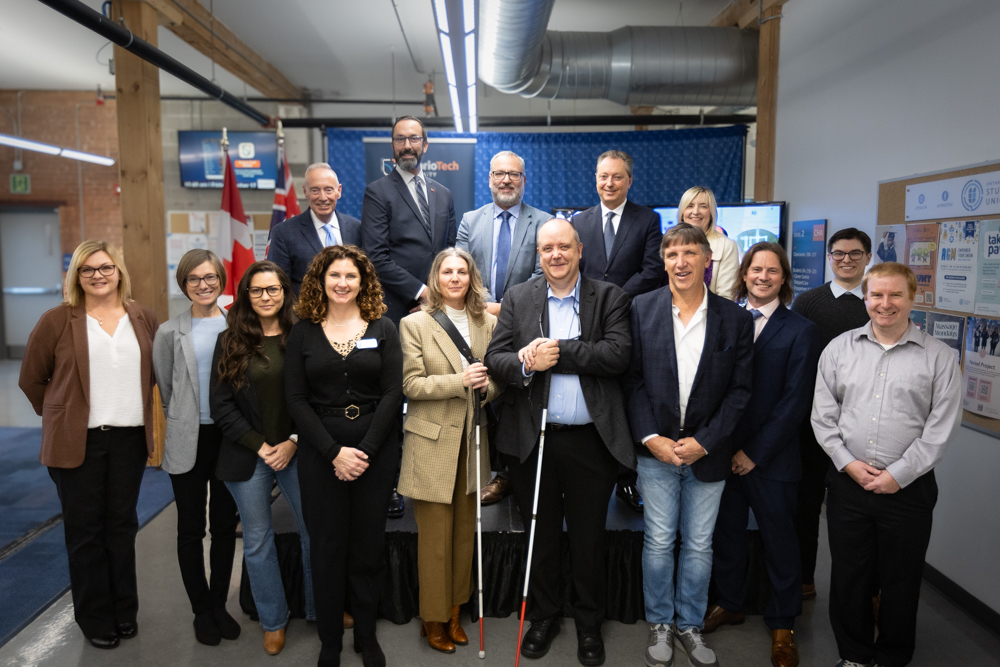UOIT researcher investigates connection between neck pain and motor skills learning
April 15, 2015

When it comes to learning new motor skills, technology can either be your friend or foe; it all hinges on how you use it. University of Ontario Institute of Technology (UOIT) human neurophysiology researcher Dr. Bernadette Murphy is investigating how abnormal postures – often caused by technology overuse – can lead to chronic neck pain, and how that pain can lead to other overuse injuries and even affect your brain’s ability to learn new motor skills. As recipient of the university’s 2014 Research Excellence Award (REA), she presented her latest research findings at the recent 2015 REA Speaker Series.
“The University of Ontario Institute of Technology is proud to have a scholar of such international reputation amongst its faculty members,” said Michael Owen, PhD, Vice-President, Research, Innovation and International. “Dr. Murphy engages in research that makes a difference in people’s daily lives, and on undergraduate and graduate education and teaching. Her work demonstrates why research really does matter.”
- Watch the video replay of Dr. Murphy’s presentation, entitled Understanding how to shape technology so it doesn’t shape us..
Where technology can hurt
Extensive technology use has been linked to neck strains and injuries. A 2014 study published in the journal Surgical Technology International found that when the neck is in a neutral position, it bears your head’s normal weight – about 10 to 12 pounds. But once the neck is flexed 60 degrees forward – a common position when you’re looking down at your cell phone - you’re putting 60 pounds of force on your cervical spine. That’s enough to cause a herniated disk.
But abnormal postures can do more than just fatigue the neck muscles and cause chronic pain. According to Dr. Murphy, Professor, Faculty of Health Sciences (FHS), they can also impact how your brain perceives your body schema – the map of your body contained within your brain.
Every move you make is based on where you perceive your body to be. Your cerebellum – the part of your brain responsible for helping you learn motor skills - helps you determine and remember the positioning of your arms in relation to your head. It’s what makes you able to place your finger on your nose while your eyes closed. A person with a healthy cerebellum has no problems doing this, but someone with cerebellar problems might miss their nose, or move their arm in an unusual direction before arriving at the nose.
“Our research has found that neck fatigue can lead to changes in the way your cerebellum perceives where other body parts – especially your upper limbs – are in relation to your neck,” she says. “It’s as if your awareness of your own body map is distorted. This can alter your motor control and impair your ability to learn motor skills.”
Dr. Murphy presented a number of studies she conducted together with students, and internal and external research collaborators. In one study, already attracting international attention, participants were asked to hold their arm in a certain position for several minutes, put their arm down and then return it to the same position. This was done before and after fatiguing the neck muscles, and the results compared. She demonstrated that when the neck muscles of healthy people are fatigued, it impairs their ability to accurately reposition their arm. This change in limb performance due to sensory input from the neck is an example of maladaptive plasticity. Chronic changes in neck input due to work posture or fatigue eventually re-program the way our brain perceives arm position. This changes the way a person make future movements, which could cause further injury if left untreated.
She also discussed studies that investigated how healthy people, as well as people with chronic, low-grade neck pain or stiffness, do the following:
- Perform movements with their arms and elbows.
- Mentally rotate two-dimensional representations of figures.
- Learn different motor skills.
- Retain and improve upon what they learn.
People in the neck pain category consistently performed poorer in all of these tasks. In one study where the neck pain was treated, they showed improvement in their motor performance.
“All of this has big implications for everyone – whether they’re office workers, or assembly line workers who are holding their necks in altered positions for long periods of time,” said Dr. Murphy. “They may not be able to perceive well where their upper limb actually is, which can lead to overuse injuries. We have to take this all into account when we’re designing technology.”
Where technology can help
When used correctly, technology can help people improve their motor skills. Dr. Murphy has worked with Dr. Andrew Hogue, Assistant Professor and Dr. Bill Kapralos, Associate Professor in the Faculty of Business and Information Technology’s Game Development and Entrepreneurship program, to develop serious games designed to help improve decision-making abilities for firefighters, who experience thermal stress on the job. The cognitive function of firefighters is impaired once their core temperature reaches 38.5 degrees Celsius. The researchers are able to replicate these temperatures in the environmental chamber at the university’s ACE facility and have the firefighters go through the simulation to train their brains to make correct decisions even when they are experiencing the stress of high temperatures.



